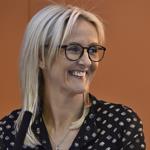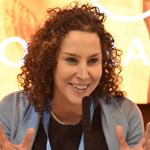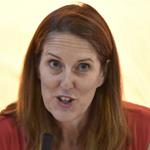Half a century will pass before the gender pay gap closes in the UK and just seven CEOs on the FTSE 100 list were women last year. Countless reports, statistics and newspaper columns all lead to the same conclusion: women still have a long way to go when it comes to achieving full equality in the workplace.
However, things may be better in optics, given that the College of Optometrist’s Optical Workforce Survey shows women have made up the majority of the workforce since 2009. Reflecting the times, this year’s Optrafair featured a BBC Question Time style Women in Optics debate to discuss issues within the industry.
The debate kicked off with a question from the floor regarding the effect on the optical industry of having more female professionals than men. Dame Mary Perkins, co-founder of Specsavers, noted that opportunities for women have increased tremendously throughout her career, given just five women were in Perkins’s academic year at Cardiff University in 1962. She said: ‘I could never have imagined women would be taking over the world of optometry. It doesn’t matter to our customers, they’re not fearful of it and I think we are creating a problem because we’re talking about it too much with our own colleagues and our business. Women are enthusiastic and valuable and tend to put more effort into working.’
Lynne Fernandes, director of Lynne Fernandes Optometrists, agreed that women often bring something different to the workforce than men. ‘The profession is becoming a more exciting and dynamic work place, it’s wonderful to have women’s voices heard. I’ve been asking men and women what they think the impact is of having extra women in the work place and the answers given by men were that women have a better bedside manner and more empathy.’
The College’s Optical Workplace Survey also reveals that women carry out the majority of part time work, a trend which Perkins claims is down to optometry and dispensing optics offering flexibility for females as well as reasonably high wages.

But Shamina Asif (pictured left), chair of Dudley Local Optical Committee (LOC), added that men too are opting for more part time work. ‘The Optical Workplace Survey noted that the generation born in the 1980s and 1990s want to work part time because they want to pursue their passions outside work. This is the trend now whereas my grandparent’s generation worked five or six days a week flat out. It’s all changed now – women and men can go part time and enjoy life at a younger age.’
More women in senior positions

Most industries suffer from a lack of diversity when it comes to women in senior roles and although the panel acknowledged optics does boast several female leaders, all note more could be done. Jayne Abel (pictured right), co-founder of Eyespace eyewear, said: ‘You don’t just become a leader, it’s an organic process. There’s lots of women out there who qualify as optometrists and just stay inside practices and don’t go further than that.’
She now wants to see more women putting themselves forward and going for the bigger jobs as well as pushing for more clinical skills. ‘We have a responsibility as directors and owners of companies to promote them. There’s millennials coming through who want to learn and want to progress.’

For women to succeed in senior roles there needs to be a movement from the ground upwards according to Jayshree Vasani (pictured left), practical examiner and practice visitor for ABDO, who commends ABDO for trying to encourage young women through its system. ‘If you are on the board bring someone else with you and show them it’s not scary,’ Vasani added.
It’s a pathway which has worked well for Asif, who is now chair of Dudley LOC and council member for the College. She said: ‘It was only when I was in a LOC that people saw the potential in me and gave me opportunities to take on tasks. I was able to progress rapidly so if you’re having difficulty then go down the LOC route.’

It is up to women who have already climbed the ladder to senior positions to encourage and mentor others, something which Dame Mary (pictured right) said doesn’t often happen. ‘Women don’t network like men do and it’s still an old men’s club – there’s still an unconscious bias stopping women going forward.’
But she reinforced the point that it’s important for women not to become too focused with their gender. ‘I can honestly say I never paid any attention to whether I was a woman I just went there and that was it,’ she added.
The debate also attempted to answer more general issues within optics, particularly the way locums are treated within the industry and whether the panel sees locums as a resource. Vasani argued locums are an added bonus in any practice. ‘They have more knowledge than most and have a wide economic base. In my practice it’s nice to chat to locums to ask what’s happening in the wider world and to see who’s doing what product.’

Yet within Wales Sali Davis (pictured left), chief executive of Optometry Wales, noted locums are currently underrepresented as they rarely get involved in optical politics. She hoped to see more locums involved in future discussions in order to get across their views to practice owners.
Future of optics
In an industry experiencing rapid changes in its technology, services and workforce all panel members agreed optics needs to be more collaborative within its various disciplines.
Davis described an instance while collecting data for the General Optical Council’s upcoming Education Review when, on behalf of Optometry Wales, she consulted with ABDO about its members. Optometrists immediately objected, questioning Davis on why she was ‘promoting dispensing opticians’. She said: ‘We really have to get better at being more professional and collaborative because if you cannot see incorporating a DO and them doing more than the regular bread and butter work in the business model then there is no hope.’

Fernandes (pictured right), who runs three successful independent practices across Bristol, looked to the multiples to set a precedent when it comes to sight test fees. She said: ‘When we’re negotiating for enhanced services we should charge a realistic fee so we can provide an excellent service and don’t have to upsell on our glasses afterwards. If we offer free sight tests we are putting optometry and patient care at risk, as well as costing secondary care more money in the long term. So that would be my heart felt plea to the big companies.’
In response Dame Mary drew parallels between the Specsavers business model and the Scottish NHS, arguing free sight tests encourage people who would have otherwise not have entered the ‘optometrist’s shop’ to have regular sight tests. She said: ‘The Scottish model had a 29% uptake in people having their eyes examined [after the introduction of free sight tests]. If I have to entice people in by waiving that charge, and believe you and me it’s a bigger uptake when that happens, then I would do that because it’s preventing sight loss.’
The free sight test debate proved to be a contentious issue with panellists disagreeing on where to draw the line. Davis received a round of applause from the audience when arguing that optometrists cannot work for free. ‘You have got to pay the optometrist and have a good practice which is well equipped and that’s achieved by having a fee for an eye test and a good fee for an enhanced service. Let’s have lots of eye tests but let’s also get paid properly for them.’
As issues surrounding women’s equality force their way into the limelight, the importance of discussion and debate becomes paramount. The Women in Optics debate demonstrated just one of many ways issues within the optical community can be appropriately and respectfully addressed.
